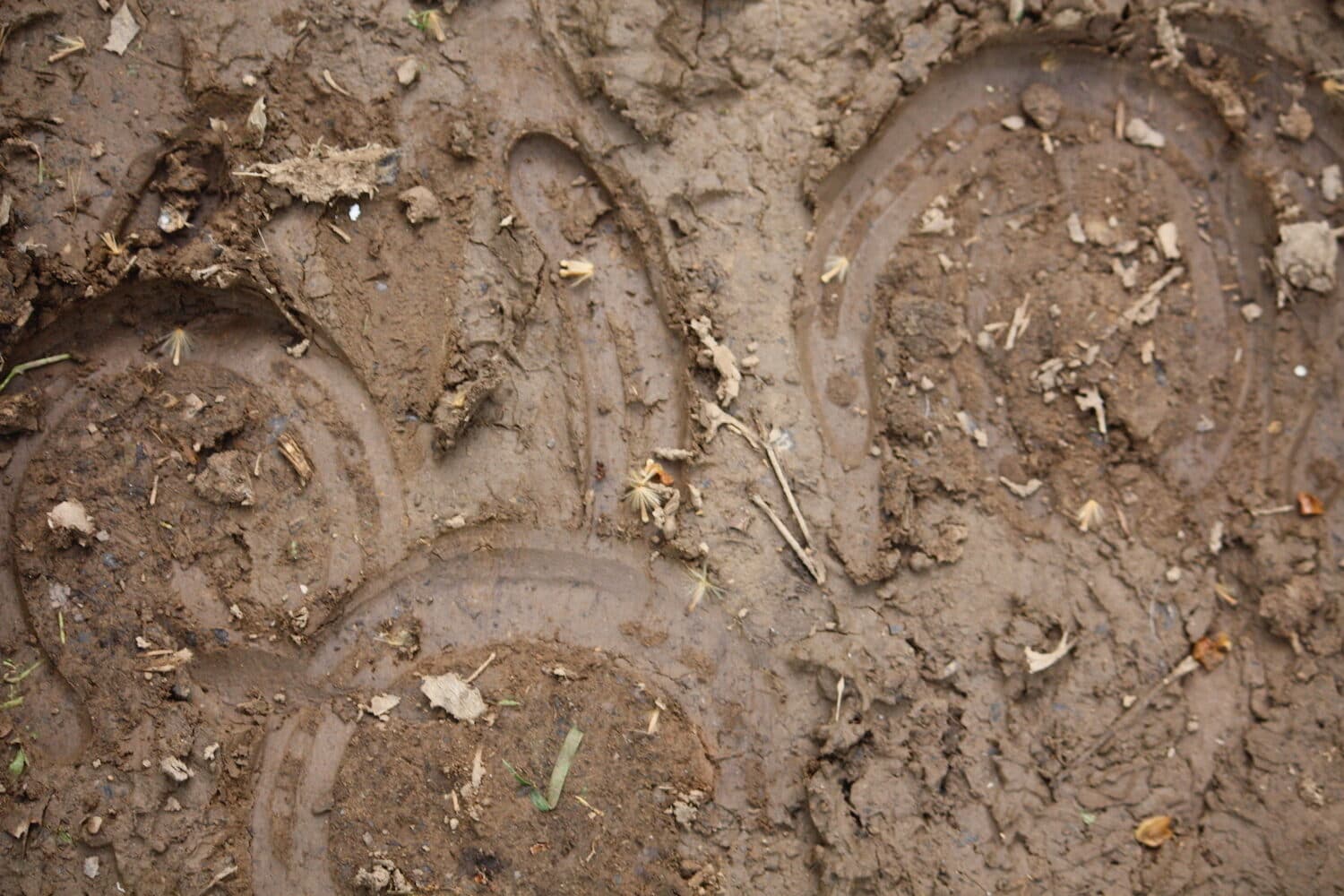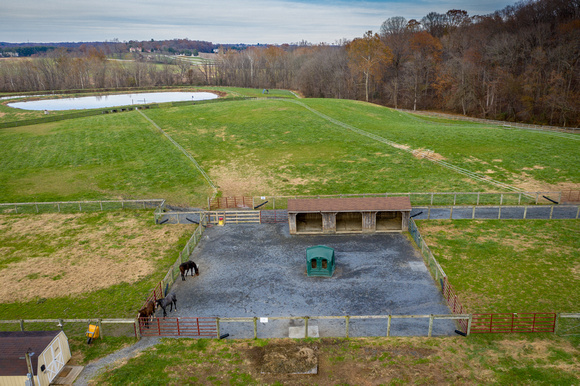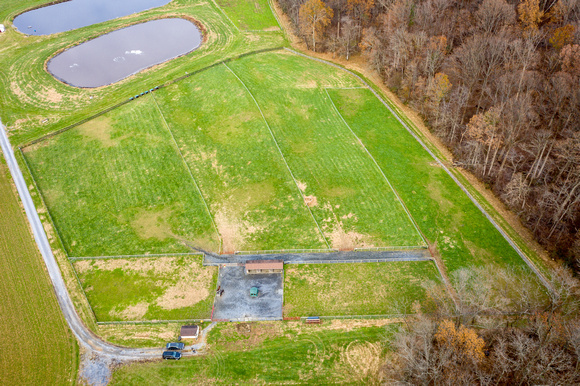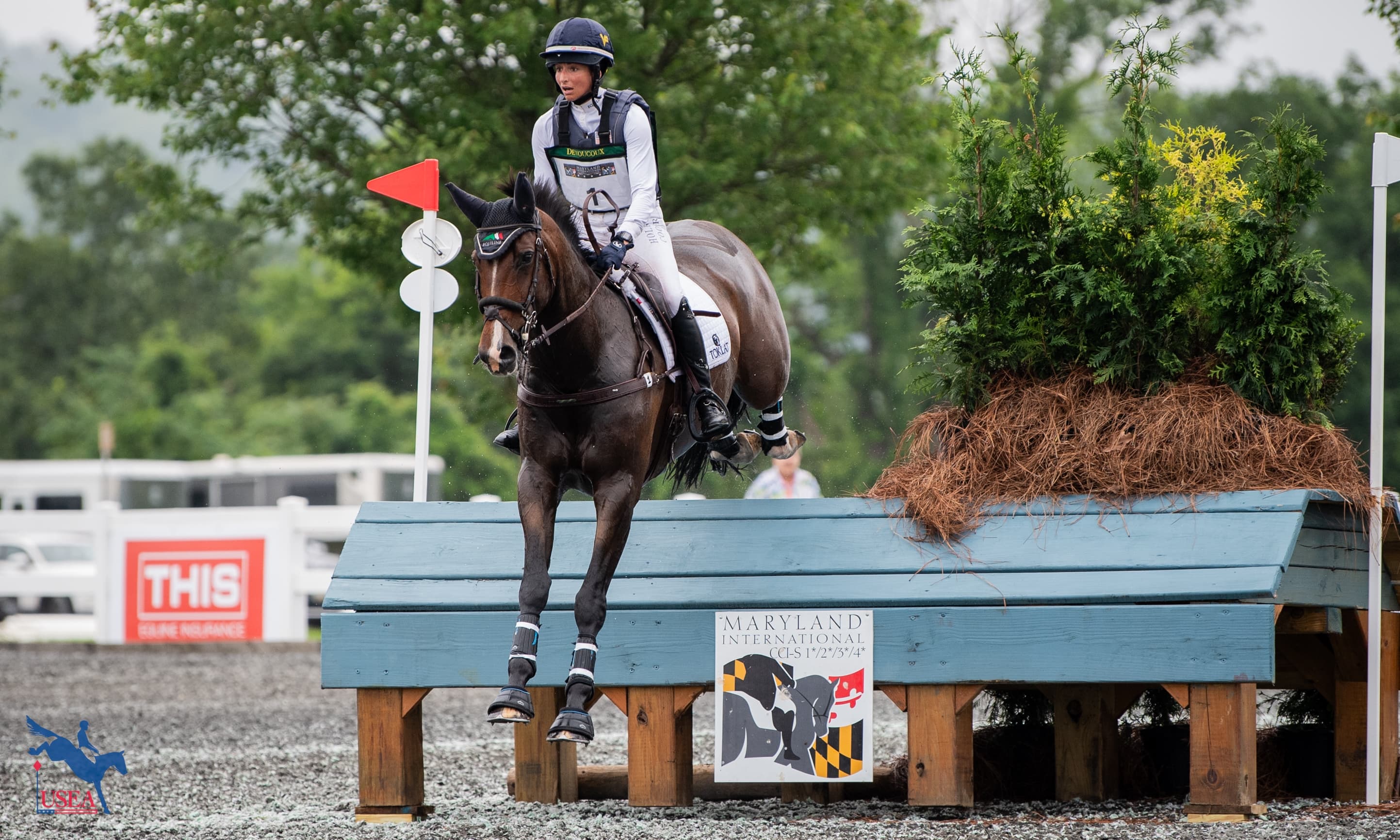Winning the Mud War on Your Farm with Erika Crowl

Whether it’s caused by a summer thundershower or a winter storm, mud is simply a part of life on a farm. Erika Crowl, the Agriculture Educator for the University of Maryland Extension program in Baltimore County, observed that every farm owner has battled mud at some time, but it’s worth trying to win the war because of the issues mud can cause.
“Mud, we know, [can cause] all sorts of issues,” Crowl began. “It transmits bacterial and fungal diseases – I’m sure we all have seen thrush in our horses’ feet, mud fever, mud scald down on their pasterns, and rain rot on their backs. Horses, when they’re laying in the mud, it reduces their core temperature, which can be harmful to them, especially if you have an older horse or a horse with metabolic issues and you’re trying to get weight on them.”
“Mud is a breeding ground for unwanted insects,” she continued. “In [Maryland] we deal with West Nile Virus and mosquitos, so we don’t want to give them any more water or have them breeding in areas where horses are.”
“Mud also increases erosion and nutrient run-off,” Crowl shared. “[The University of Maryland] really strives with our nutrient management program, trying to make sure that we are decreasing erosion and making sure our nutrients from fertilizers and manure are contained and not running off into our bay. It also reduces farm efficiency – no one wants to be slopping around in the mud, tripping and losing your boots when you’re trying to bring in horses. We want to make it easy for us and our horses.”
What Causes Mud?
It may seem like a silly question, but there are more contributing factors to mud than just water. Everything from soil type, drainage, and grass growth can affect how mud spreads on your farm.
Clay-type soils tend to hold water more than other types of soil, making areas heavy in clay-type soil more prone to mud. “In this region, we don’t have a ton of clay, but we have enough that we find water being retained in our soils and it’s not draining as easily as, say, if we were on the shore with sandy-type soils,” Crowl observed.
Fields in lower elevation also tend to struggle with drainage, making them more susceptible to mud. “if you’re next to a creek bed, you can find that your field can get pretty swampy quickly.” In fact, any area that struggles with drainage, like a roof runoff area from a structure with no gutters, will be more prone to mud. That issue can be compounded when the pasture lacks plant roots to support the soil, so proper pasture management is key in avoiding mud.
Areas with excess manure also tend to experience a buildup of mud because that manure holds water and contributes to the saturation of the ground when it’s not cleaned up appropriately. High traffic areas, like gates, hay feeders, or waterers, will also develop mud as the horses churn up the ground with their feet.
What’s the Solution?
You know what’s causing the mud on your farm, so what steps can you take to mitigate it? It depends on a couple of things – the cause of the mud, how your property drains, and your budget for fixing the problem. “We can have very economical solutions or we can have pretty pricey solutions – it all depends on your budget,” Crowl said.
Crowl’s first suggestion is focusing on your pasture management techniques. Start with soil testing – make sure you’re adding appropriate amounts of lime and fertilizer to your pastures to support the grass. Don’t overgraze your pastures, as this puts undue strain on the root structure. Make sure to mow and engage in weed control to support proper grass growth.
Overseeding and then allowing a season for growth can be a strategy to help muddy pastures recover. “You really want [your pasture] to have a root structure – horses are hard on the ground and they’re hard on the fields. They will pick up the roots right away and destroy everything that you’ve done, so you really want to let [the grass] grow up.” Crowl suggests seeding one pasture at a time, rather than doing all your pastures at once, so that the non-seeded pastures can support the horses while the seeded pasture is recovering.
Another important management technique is keeping your horses off of pasture when it’s wet. “If your horses are on those wet pastures, they’re just damaging the plant roots, they’re compacting the soil, and when the soil is compacted the infiltration is decreased . . . [the ground is] broken up, there are clots of mud everywhere. We really don’t want our fields to look like that!”
To keep horses off of pastures when they’re wet, Crowl suggests using what she calls a “sacrifice area” – a smaller area where you can confine your horses during the winter and early spring, or anytime the pasture is too wet or has been overgrazed. You want to make sure this area is somewhere with higher elevation to help with drainage, and make sure it has enough space for the number of horses it will need to accommodate – Crowl recommends an average of 600 square feet per horse, but your needs may differ based on your horse’s age and mobility.

When putting together a sacrifice area, it’s important to consider which footing you’ll use. Hog fuel, or wood chips, is Crowl’s first suggestion. The advantages of wood chips are that they’re relatively economical, they help reduce odor, and they provide a cushioned surface. However, wood chips decompose quickly and a new layer will likely need to be added every season.
Gravel or sand is Crowl’s next recommendation. Gravel, applied at a 6- to 8-inch thickness, or sand at 4 inches, can last for years and provide a solid footing for your sacrifice area. Gravel or sand will eventually migrate into the soil, requiring replacement, and gravel footing is more expensive than wood chips.
Crowl’s favorite solution, which is also the most expensive, is using a geotextile fabric. The cloth is laid at the bottom and covered with stone and gravel to create drainage and keep the soil stable. “It’s a long-term investment,” Crowl said when acknowledging that this is the priciest option of the three.
Rotational grazing as a part of good pasture management helps preserve root structure. Crowl recommends grazing fields with growth from 6-10 inches and rotating horses off those fields when the pasture has been eaten down to 4-5 inches. In the springtime, grass grows more quickly and rotations should be consequently more frequent than in the summer months.
High-traffic areas, particularly gateways and watering areas, require special management to avoid mud. Adding some type of surface (gravel, sand, etc.) to stabilize the soil will help. For waterers, sometimes a small concrete pad is poured for the horses to stand on while drinking from the waterer, but erosion can sometimes occur around these pads. Similar issues can occur around hay feeders, and Crowl recommends feeding in the sacrifice area instead of in the pasture, especially in the winter months. If that’s not an option, moving the hay feeder around the field will help mitigate this issue.

Managing stormwater with gutters is another important part of dealing with mud on your farm. Placing gutters on your run-in sheds can help divert water away from your pastures and direct it across your property so that it doesn’t cause mud. Crowl cited guidelines from Rutgers University on French Drain systems that can divert water away from your buildings and fields.
“Grass buffer strips are important,” Crowl said. “This can act as a natural filtration system that will slow down the runoff, especially around your sacrifice areas. If the sacrifice area is located near a stream you should have a buffer around the sacrifice area, and you can make these buffer 50 feet wide and then flash-graze them in the springtime.”
Planting trees and shrubs is a long-term solution that can help pull water out of the ground. “Evergreens use water in the winter, so that’s something to keep in mind as well,” Crowl shared. If the trees and shrubs are planted inside the pastures, you can put cages or fences around them so the horses don’t chew on them or rub on them, and make sure to plant non-poisonous varieties.
Manure management is a key piece of mud control. Regular manure removal will greatly reduce the instance of mud in your pastures and paddocks and helps prevent contaminated runoff from reaching the surface water. Using the manure as compost to spread on pastures during the growing season is an option for repurposing manure. During the rainy season be sure to keep your manure pile covered!
“At the end of the day, I want you to remember we should be managing our pastures properly,” Crowl concluded. “Keep the horses off of any wet pastures. Prevent any manure, hay, and bedding from accumulating anywhere. In your sacrifice area, and even if you have small acreage, clean up your manure! Drag the fields in the summer – make sure you’re getting rid of any waste. Improve the drainage around your barns or run-in sheds. Manage your stormwater with the drains, gutters, and downspouts. And, if possible, create a sacrifice area to reduce mud so your horses can have somewhere else to go during the wet times. It will make your life easier in the long run!”
Interested in learning more? Check out Crowl’s full presentation here. Thank you to the University of Maryland Horse Extension program for making this presentation available.
About Erika Crowl
Erika Crowl is the Agriculture Educator for the University of Maryland Extension program in Baltimore County. She started with the University of Maryland Extension program as a Nutrient Management Advisor in 2016 and moved to her current role as an Agriculture Educator in 2018. Erika graduated from Colorado State University with a Bachelor of Science in Equine Science. She provide outreach and education in the areas of equine livestock management, pasture management, and soil health. As a Harford County native, Erika grew up with the Elkridge-Harford Hunt Pony Club. In her spare time, she enjoys foxhunting with the Elkridge-Harford Hunt and Mt. Carmel Hounds and rides amateur steeplechase and flat races throughout the year.














